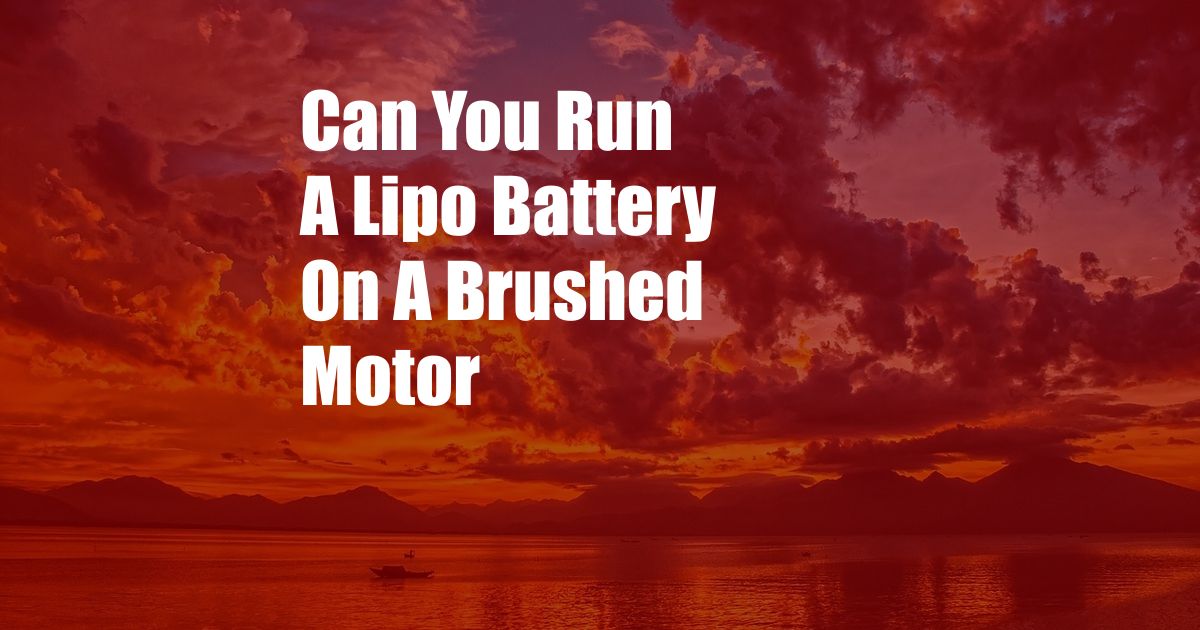
Can You Run a Lipo Battery on a Brushed Motor?
In the realm of radio-controlled hobbies, the choice between lipo batteries and brushed motors can significantly impact performance. LiPo batteries, known for their high energy density and lightweight, offer extended runtime and power. On the other hand, brushed motors are widely used due to their affordability and compatibility with various power sources.
A common question among hobbyists is whether it’s possible to combine the advantages of LiPo batteries with the practicality of brushed motors. This article will explore the intricacies of using LiPo batteries in conjunction with brushed motors, providing a comprehensive guide for enthusiasts.
LiPo Batteries and Brushed Motors
LiPo (Lithium Polymer) batteries excel in providing high voltage and discharge rates, making them ideal for applications requiring bursts of power. Brushed motors, on the other hand, are simpler in design, consisting of a rotating armature within a fixed magnetic field. While they offer lower efficiency and higher maintenance compared to brushless motors, their cost-effectiveness and versatility make them popular in entry-level RC models.
Compatibility Considerations
The compatibility between LiPo batteries and brushed motors depends on several factors, including voltage and current handling capabilities. LiPo batteries typically operate at higher voltages than traditional NiMH batteries, and it’s crucial to ensure that the brushed motor is rated to handle the increased voltage. Exceeding the motor’s voltage limit can lead to overheating and damage.
Additionally, brushed motors draw higher current than brushless motors, and the LiPo battery must be capable of delivering the required current without overheating or sagging. Using a battery with insufficient current capacity can result in decreased performance or even premature battery failure.
Voltage Regulation and Protection
To prevent over-voltage damage to the brushed motor, it’s essential to employ voltage regulation measures. A voltage regulator, such as a simple Zener diode, can be used to limit the voltage supplied to the motor, ensuring it remains within its safe operating range.
Furthermore, a low-voltage cut-off (LVC) circuit can be implemented to protect the LiPo battery from over-discharging. LiPo batteries should not be discharged below a certain voltage threshold to prevent irreversible damage. The LVC circuit monitors the battery voltage and disconnects the motor when the voltage drops below the threshold.
Tips for Using LiPo Batteries with Brushed Motors
Here are some expert tips to enhance the performance and safety of using LiPo batteries with brushed motors:
- Choose a suitable voltage regulator: Determine the maximum voltage rating of the brushed motor and select a voltage regulator that can limit the voltage accordingly.
- Use a low-voltage cut-off circuit: Implement an LVC circuit to protect the LiPo battery from over-discharging.
- Monitor battery temperature: Regularly check the temperature of the LiPo battery during use. Excessive heat can indicate a problem and should be addressed promptly.
- Maintain the motor: Regularly clean and lubricate the brushed motor to ensure optimal performance and reduce wear.
- Observe proper charging and storage practices: Follow the manufacturer’s recommendations for charging and storing LiPo batteries to ensure their longevity and safety.
Frequently Asked Questions
Q: Can all brushed motors be used with LiPo batteries?
A: No, not all brushed motors are compatible with LiPo batteries. Ensure that the motor is rated for the voltage and current requirements of the LiPo battery you intend to use.
Q: How can I determine the voltage regulator value?
A: The voltage regulator value should be chosen based on the maximum voltage rating of the brushed motor. For example, if the motor is rated for 12V, a 12V Zener diode can be used as the voltage regulator.
Q: What is the purpose of a low-voltage cut-off circuit?
A: An LVC circuit prevents over-discharging of the LiPo battery by disconnecting the load when the battery voltage drops below a preset threshold.
Conclusion
While using LiPo batteries with brushed motors requires careful consideration and proper precautions, it can provide significant performance advantages in terms of power and runtime. By implementing voltage regulation, low-voltage cut-off protection, and following safe operating practices, hobbyists can harness the benefits of LiPo batteries while ensuring the longevity and safety of their brushed motors.
If you’re considering using LiPo batteries with brushed motors, we encourage you to research further and consult with experienced hobbyists to optimize your setup and enjoy the full potential of this combination.